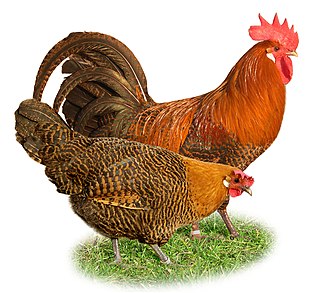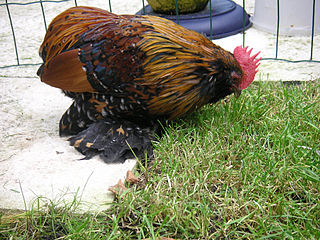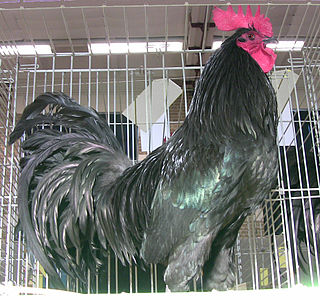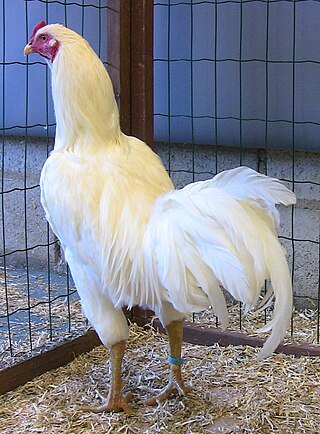
The American Game is an American breed of game fowl, chickens bred specifically for cockfighting. It has many color varieties, and may also be kept for ornament.

The Leghorn, Italian: Livorno or Livornese, is a breed of chicken originating in Tuscany, in central Italy. Birds were first exported to North America in 1828 from the Tuscan port city of Livorno, on the western coast of Italy. They were initially called "Italians", but by 1865 the breed was known as "Leghorn", the traditional anglicisation of "Livorno". The breed was introduced to Britain from the United States in 1870. White Leghorns are commonly used as layer chickens in many countries of the world. Other Leghorn varieties are less common.

The Braekel or Brakel is a traditional Belgian breed of chicken. It is thought to have originated in the area of Brakel, in the Flemish province of East Flanders, for which it is named. There is a bantam version of the Braekel. The Campine of the United Kingdom derives from it.

The Cochin is a breed of large domestic chicken. It derives from large feather-legged chickens brought from China to Europe and North America in the 1840s and 1850s. It is reared principally for exhibition. It was formerly known as Cochin-China.

The Indian Game is a British breed of game chicken, now reared either for meat or show. It originated in the early nineteenth century in the counties of Cornwall and Devon in south-west England. It is a heavy, muscular bird with an unusually broad breast; the eggs are brown.

The Dominique is an American breed of chicken, characterized by black-and-white barred plumage and a rose comb. It is considered to be the oldest American chicken breed, and is thought to derive from birds brought to America by colonists from southern England. It was well known by about 1750, and by the mid-nineteenth century was widely distributed in the eastern United States. It is a dual-purpose breed, but is kept principally for its brown eggs. It became an endangered breed in the twentieth century, but numbers have since recovered.

The Old English Game is a British breed of domestic chicken. It was probably originally bred for cockfighting. Two different standards are recognised by the Poultry Club of Great Britain: Carlisle Old English Game and Oxford Old English Game. There is also an Old English Game bantam.
The Taiwanese Game or Taiwan is a breed of large game chicken originating in the island of Taiwan. It is among the largest of chicken breeds, and may exceed 10 kg in body weight. It shows some similarity to large Japanese Shamo birds and, although it does not originate in Japan, may also be known as the Taiwanese Shamo. Large game chickens of this type but of indeterminate breed may sometimes be marketed as "Taiwan" or – in the United States – as "Saipan", "Saipan Jungle Fowl" or "Chinese Shamo".

The Hamburg, Dutch: Hollands hoen, German: Hamburger, is a breed of chicken which is thought to have originated in Holland sometime prior to the fourteenth century. The name may be spelled Hamburgh in the United Kingdom and in Australia.

The New Hampshire Red or New Hampshire is an American breed of chicken. It was developed in the early twentieth century in the state of New Hampshire by selective breeding of Rhode Island Red stock; no other breed was involved. It is fast-growing, early-maturing, quick-feathering, and yields a meaty carcass. Mature birds are a light or medium red in color; they may fade in sunlight.

The Barbu d'Uccle or Belgian d'Uccle, Dutch: Ukkelse Baardkriel, is a Belgian breed of bearded bantam chicken. It was first bred in the town of Uccle on the outskirts of Brussels, in central Belgium, in the early years of the twentieth century. It is a true bantam, with no standard-sized large fowl counterpart, and is one of eleven Belgian true bantam breeds.

The Appenzeller Spitzhauben is a Swiss breed of crested chicken originating in the historical Appenzell region of Switzerland. It is one of two chicken breeds from that area, the other being the Appenzeller Barthuhn; the only other Swiss breed of chicken is the Schweizer.

The Dutch Bantam is a breed of bantam chicken originating in the Netherlands. It is a true bantam, a naturally small bird with no related large fowl from which it was miniaturized. It is kept mainly for exhibition, and has been bred in many color varieties; it is a good layer of small eggs.

The Modern Game is a British breed of ornamental chicken which originated in England between 1850 and 1900. It was bred from gamecock stock, but solely as an exhibition bird.

The Barbu d'Everberg, is a Belgian breed of bantam chicken. It is a tailless variant of the Barbu d'Uccle, and was bred in about 1906 at the Château d'Everberg, at Everberg in the municipality of Kortenberg, between Brussels and Leuven. It is among the most endangered chicken breeds in Belgium, and in 2010 its conservation status was classed as "critical". It is a true bantam, with no large counterpart. Cocks weigh 700–800 grams, and hens 550–650 g.

The Tōmaru (唐丸) is a Japanese breed of long-crowing chicken. The crow may be sustained for some 25 seconds. It is one of four Japanese long-crowing breeds, the others being the Koeyoshi, the Kurokashiwa and the Tōtenkō.

The Onagadori is a historic Japanese breed of chicken, characterised by an exceptionally long tail. It was bred in the seventeenth century in Kōchi Prefecture, on Shikoku island in southern Japan, and was designated a Japanese National Natural Treasure in 1952. It is one of the ancestors of the German Phoenix breed.
The Yakido is a Japanese breed of fighting chicken. It belongs to the Shamo group of breeds. It was bred in the Kansai region in southern Honshu in the mid-nineteenth century. It was made a Natural Monument of Japan in 1950.

The Satsumadori is a Japanese breed of chicken. It originated in Kagoshima Prefecture, in the southernmost part of the island of Kyushu in southern Japan, and was originally bred for cockfighting. The name derives from that of the former province of Satsuma, now the western part of Kagoshima Prefecture.

The Appenzeller Barthuhn is a Swiss breed of bearded chicken originating in the historical Appenzell region of Switzerland. It is one of two chicken breeds from that area, the other being the Appenzeller Spitzhauben; the only other Swiss breed of chicken is the Schweizer.



















